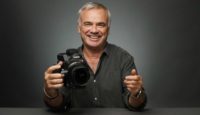HPA Tech Retreat: The Latest Workflows for Virtual Production
February 20, 2020
The HPA Tech Retreat kicked off with an ambitious daylong demo that highlighted innovations in content creation, management and distribution technology and workflows. Supersession chair Joachim Zell, VP technology for EFILM walked the audience through numerous elements of an HDR production: filming, editing and finishing two scenes that provided the final chapters for a short film. The process, much of which involved workflows in the cloud, featured multiple cameras, on-set management and collaboration platforms, editorial, dailies and digital intermediate color grading systems, as well as online mastering and distribution platforms.
Sam Nicholson (below), CEO and founder of Stargate Studios, took to the stage-turned-film set for the first demo. He oversaw a virtual production shoot that deployed RED Monstro and ARRI Alexa cameras, as well as his company’s new proprietary toolset called ThruView. They captured a simulated moving train sequence with live actors and a dining car interior set flanked by LED walls displaying background scenic imagery. The lighting, reflections and live action/CG backdrops were all under dynamic control and captured with the performance as an integrated image in real-time, eliminating the need for green screen and postproduction comps.

According to Nicholson, it was a process he has been experimenting with for a long time, and an earlier iteration can be seen on test footage he oversaw for the unproduced television series “Star Wars: Underworld.” Nine years later with the advent of 8K capture, OLEDs, powerful GPUs and advances in VR, the technology is ready.
In fact, Stargate recently wrapped another more ambitious project that used virtual production to create a train journey. Nicholson and Stargate pushed the technology as far as they could to produce 3,000 shots with 40 train windows for HBO’s upcoming comedy series “Run.”
Nicholson said, “We captured nearly 200 terabytes of data. From a post standpoint, we could handle that amount of data at Stargate, but for the set, we had to invent wireless camera tracking that was less bulky and less expensive than was available on the market.”
Nicholson shot two image streams simultaneously on “Run” to provide HBO with the creative flexibility, economies and efficiencies afforded by virtual production along with the freedom to change things in post. The focus, however, was on “fixing it in prep and moving the tools from post up front” as much as possible, and allocating post for correcting moiré, synchronicity and other issues that emerged during the shoot.
For virtual production to work, explained Nicholson, “Producers and directors need to be more responsible about making decisions in prep — they need to commit.”

No Comments Yet
You can be the first to comment!
Sorry, comments for this entry are closed at this time.